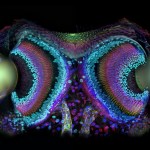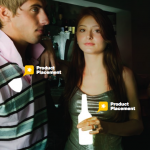Science
Earlier this week, I talked about the technical requirements for taking a picture of an interference pattern from two independent lasers, and mentioned in passing that a 1967 experiment by Pfleegor and Mandel had already shown the interference effect. Their experiment was clever enough to deserve the ResearchBlogging Q&A treatment, though, so here we go:
OK, so why is this really old experiment worth talking about? What did they do? They demonstrated interference between two completely independent lasers, showing that when they overlapped the beams, the overlap region contained a pattern…
This year's winner of the BioScapes digital imaging competition, Igor Siwanowicz, triumphed with a somewhat unusual portrait. To most biologists, it should be clear what anatomical structures are shown here - but what species could this be?
Igor Siwanowicz, Max Planck Institute for Neurobiology, Munich, Germany.
First Prize, 2010 Olympus BioScapes Digital Imaging Competition®.
click through for the answer, and for my picks of the other winners. . .
That's Dr. Siwanowicz' frontal section of Daddy Longlegs (Phalangium opilio) eyes, showing lenses (two large ovals), retinas and optic nerves…
Hannah Waters at Culturing Science has written a lovely little post on the day-to-day benefits of having a scientific worldview:
I grew up immersed in science. Any facts that exist that I couldn't reconcile with experience, I just chalked up to the limitations of my senses or even my brain's ability to conceptualize (the latter usually reserved for when I'm dealing with astrophysics). But if you aren't well-versed in how science works and perhaps the basics, this stuff sounds completely insane!
Read more here. While I'm not quite as optimistic that the power of awesome, or science…
I'm grading a big backlog of homeworks today, so I don't have time to do any really lengthy posts this morning. Thus, a poll question inspired by going through these homeworks:
You are doing a physics homework problem. How many significant figures do you report?survey software
While the class in question uses some quantum ideas, the poll is strictly classical, so no superpositions of multiple answers are allowed.
(Honestly, at some point, I would expect laziness alone to compel people to round their answers off before their hands cramp up from copying all these digits...)
The New York Times decided earlier this week that biological animation warrants its own article. About time! :)
Seriously, for those of you who haven't discovered BioVisions' amazing animations, you should check them out and/or use them in class - with the caveat that they're not "pure" data:
While acknowledging the potential to help refine a hypothesis, for example, some scientists say that visualizations can quickly veer into fiction. "Some animations are clearly more Hollywood than useful display," says Peter Walter, a Howard Hughes Medical Institute investigator at the University of…
The big physics-y news story of the moment is the trapping of antihydrogen by the ALPHA collaboration at CERN. The article itself is paywalled, because this is Nature, but one of the press offices at one of the institutions involved was kind enough to send me an advance version of the article. This seems like something that deserves the ResearchBlogging Q&A treatment, so here we go:
OK, what's the deal with this paper? Well, the ALPHA collaboration is announcing that they have created antihydrogen atoms-- that is, a single antiproton orbited by a single positron-- at low temperatures, and…
So, if you look at this picture:
You might be asking yourself "Why does Debbie Harry rate Secret Service protection?" But no, this isn't a photo from some alternate universe where the lead singer of Blondie went on to become leader of the free world, it's part of the Rock Stars of Science campaign by the Geoffrey Beene Foundation. They've just rolled out a new campaign in GQ magazine, putting seventeen prominent biomedical researchers in fancy photo spreads with eight different musicians. It's part of an initiative to raise the profile of science by portraying scientists in a more glamorous…
Woo-meisters love to build massive straw men about what skepticism is, the better to tear it down with gusto and paint skeptics as close-minded "debunkers." I just came across a video that does just that (click on the link for even more straw men in addition to the video), but in one of the most overblown and ridiculous ways I've ever seen. Can you count the number of straw men and outright lies about skepticism and skeptics in this video?
I lost track fairly early on, so fast and furious came the misinformation, particularly because the portrayal of skeptics and skepticism wasn't even…
Fall term classes ended yesterday, officially-- my last class was Friday-- so I'm shifting over to spend more time working on the sequel to How to Teach Physics to Your Dog, which involves talking to Emmy about relativity. Progress has been slower than last time, largely because the previous book was written while I was on sabbatical and before SteelyKid was born. But there's also a structural issue that's giving me some problems.
This is partly a matter of familiarity with the material-- I'm a low-energy physicist, so I've never needed to worry all that much about relativity. A bigger issue…
This is adapted from an answer to a question at the Physics Stack Exchange site. The questioner asked:
It seems that if the coherence length of a laser is big enough, it is possible to observe a (moving) interference picture by combining them. Is it true? How fast should photo-detectors be for observing of the interference of beams from two of the "best available" lasers?
This is a question about the itnerference of light waves, which is traditionally demonstrated via the famous "double slit" experiment, where a single laser is sent through a barrier with two narrow slits cut in it. The…
With a poster titled "WE NEED YOUR BODY! For a UNIQUE OPPORTUNITY," microbiologist Steven Park and artist Anne Brodie invited attendees at the British Science Festival to
stand NAKED inside our live bioluminescent photograph booth and have your photograph taken. Enveloped by a living ethereal blue green light, the resulting faint and ghostly image will be used as part of an [art] installation. . .
The eerie results, which look a whole lot like TSA millimeter-wave scans, are appearing in an exhibition at the UK's Royal Institution through December 3. See a slideshow at the Londonist.
As mentioned in yesterday's post on ion trapping, a month or so back Dave Wineland's group at NIST published a paper in Science on using ultra-precise atomic clocks to measure relativistic effects. If you don't have a subscription to Science, you can get the paper for free from the Time and Frequency Division database, because you can't copyright work done for the US government.
This paper generated quite a bit of interest when it came out, because it demonstrates the time-slowing effects of relativity without any need for exotic objects like black holes or particle accelerators-- they deal…
There's a new physics Q&A site from the folks at Stack Exchange, this one on physics. If you're not familiar with the format, it's a bulletin-board style site where you can post questions to be answered by other users, and people vote the answers up and down, so you can get a decent feel for which answers are good, and which are less useful.
There's a pretty wide range of questions, covering everything from really basic concepts to fairly technical questions about current research. My own feeling about this is that if you're going to have it on the public web, you ought to expect and be…
Do you know how many theoretical astrophysics tenure track positions there are each year?
About 5.
I am also interested in string theory...
Something went wrong with the GRE test in october.
Again.
Here is the official word from ETS
The GRE test administered in China, on Oct 23rd, was an old test.
GRE is offering free retakes next week or reimbursment.
This will seriously mess up grad school applicants from China, and not at a good time, with a lot of universities worried about funding and overcommittment on grad students recruitment (although I should note that some universities are taking opportunity and ramping up recruitment, for now, or deciding to gamble and plan on the funding situation improving).
So... is this a minor…
One of the many physics stories I haven't had time to blog about recently is the demonstration of relativistic time effects using atomic clocks. I did mention a DAMOP talk about the experiment, but the actual paper was published in Science (and is freely available from the NIST Time and Frequency Division (PDF file), because you can't copyright work done at government labs) a month and a half ago, and generated a bit of buzz at the time.
Given the delay between publication of the article and me blogging about it, I feel obliged to provide a little more detail than you'll get from the news…
For health organizations, federal agencies and nonprofits alike, it's a challenge to get anyone to pay attention long enough to hear your prevention messages, much less to actually change their behavior as a result. It's even harder with kids. It's not that they don't care about science; quite the contrary, they love it - especially if it's gross. It's more that they don't want to hear an authority figure talking down to them about the parade of terribles that will befall them if they binge drink, have unprotected sex, etc. Be honest: can you think back to your high school health classes…
We've just recently completed pre-registration for Winter term classes, so I've been thinking a bit about why students do and do not sign up for things. Thus, a poll:
You are a college student considering an elective class in your major, and you see it has a lab. Your reaction is:survey software
Feel free to replace "English" with the non-lab-science major of your choice when answering.
The American Institute of Physics has a statistics division that produces lots of interesting analyses of issues relevant to the discipline. A couple of them were released just recently, including one on the job status of new Ph.D.'s (PDF). The key graph from the report is this one:
The text of the report talks up the recent decrease in the number of post-doc jobs and increase in potentially permanent positions, but the long term trend looks pretty flat to me-- averaged over the thirty years of data, it looks like a bit more than half of new Ph.D.'s have always taken post-doc positions, and…
Last week's guess-the-number contest for my spare copy of Massive by Ian Sample generated over 150 comments. So, who won? Well, I said at the time:
I am thinking of an integer between 0 and 1000 (inclusive). The person who comes closest to guessing the number by midnight Eastern time Friday, November 5 wins a copy of Massive.
The number I was thinking of when I typed that was 137. Which, interestingly, was guess by two nearly simultaneous comments, numbers 10 and 11, by Nathan and Derek R. Clearly, these two know their physicist psychology-- 137 is a weirdly important number in physics, as…

